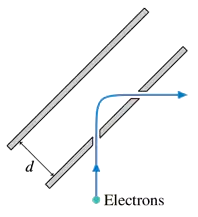 Back
BackProblem 55a
A problem of practical interest is to make a beam of electrons turn a 90° corner. This can be done with the parallel-plate capacitor shown in FIGURE P23.55. An electron with kinetic energy 3.0×10−17 J enters through a small hole in the bottom plate of the capacitor. Should the bottom plate be charged positive or negative relative to the top plate if you want the electron to turn to the right? Explain.
Problem 59
INT In a classical model of the hydrogen atom, the electron orbits the proton in a circular orbit of radius 0.053 nm. What is the orbital frequency in rev/s? The proton is so much more massive than the electron that you can assume the proton is at rest.
Problem 61b
An electric field can induce an electric dipole in a neutral atom or molecule by pushing the positive and negative charges in opposite directions. The dipole moment of an induced dipole is directly proportional to the electric field. That is, , where α is called the polarizability of the molecule. A bigger field stretches the molecule farther and causes a larger dipole moment. An ion with charge q is distance r from a molecule with polarizability α. Find an expression for the force ion on dipole.
Problem 68a
A rod of length lies along the -axis with its center at the origin. The rod has a nonuniform linear charge density , where a is a constant with the units C/m2. Draw a graph of versus over the length of the rod.
Problem 68b
A rod of length lies along the -axis with its center at the origin. The rod has a nonuniform linear charge density , where a is a constant with the units C/m2. Determine the constant a in terms of and the rod's total charge .
Problem 68c
A rod of length L lies along the y-axis with its center at the origin. The rod has a nonuniform linear charge density , where a is a constant with the units C/m2. Find the electric field strength of the rod at distance x on the x-axis.
Problem 70c
An infinitely long sheet of charge of width L lies in the xy-plane between x = -L /2 and x = L /2. The surface charge density is h. Draw a graph of field strength E versus x for x > L /2.
Problem 72
One type of ink-jet printer, called an electrostatic ink-jet printer, forms the letters by using deflecting electrodes to steer charged ink drops up and down vertically as the ink jet sweeps horizontally across the page. The ink jet forms 30-μm-diameter drops of ink, charges them by spraying 800,000 electrons on the surface, and shoots them toward the page at a speed of 20 m/s . Along the way, the drops pass through two horizontal, parallel electrodes that are 6.0 mm long, 4.0 mm wide, and spaced 1.0 mm apart. The distance from the center of the electrodes to the paper is 2.0 cm. To form the tallest letters, which have a height of 6.0 mm, the drops need to be deflected upward (or downward) by 3.0 mm. What electric field strength is needed between the electrodes to achieve this deflection? Ink, which consists of dye particles suspended in alcohol, has a density of 800 kg/m3.
Problem 73
A proton orbits a long charged wire, making revolutions per second. The radius of the orbit is cm. What is the wire's linear charge density?

